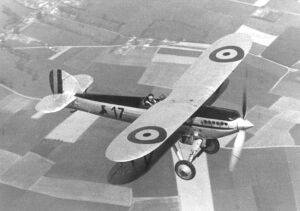Engineering:Fairey Firefly IIM
The Fairey Firefly IIM was a British fighter of the 1930s. It was a single-seat, single-engine biplane of all-metal construction. Built by Fairey Aviation Company Limited, it served principally with the Belgian Air Force throughout the 1930s until the outbreak of World War II.
Design and development
The Firefly was a private-venture design, penned by Marcel Lobelle, as the Curtiss D-12 powered Firefly I had been rejected owing to its American engine and its wooden structure, and could not be easily fitted with the larger and heavier geared Rolls-Royce Falcon XI favoured by the RAF.[1][2] A completely new design, it shared little with the Firefly I beyond the name. Making use of experience gleaned from the earlier machine, it was developed in response to Specification F.20/27 for a single-seat interceptor. It first flew on 5 February 1929.[1]
The Firefly II competed for the RAF contract against the Hawker Fury, showing superior speed but was criticised for having heavier controls.[1] Crucially, it retained a mainly wooden structure despite the Air Ministry's demands for metal structures. This led to the Fury being selected. Afterwards, the prototype was rebuilt and renamed Firefly IIM, the "M" denoting the all-metal construction of the rebuilt machine.
A revised prototype with longer-span wings, the Firefly III was built to Specification N21/26 as a carrier-based fighter to replace the Fleet Air Arm's Fairey Flycatchers, first flying on 17 May 1929.[3] Like the land-based fighter, it was rebuilt with more metal components as the Firefly IIIM, and again like the Firefly II, was beaten by a design produced by Hawker, in this case the Hawker Nimrod. Although no production orders ensued, the Firefly IIIM was fitted with floats and used as a trainer by the RAF's High Speed Flight preparing for the 1931 Schneider Trophy race.[4]
Operational history
A contract was won for 25 IIM aircraft for Belgium's Aviation Militaire, followed by a contract for a further 62 to be constructed by Avions Fairey, Fairey's Belgian subsidiary. The Belgian aircraft served briefly in the Second World War from May to June 1940.
Two of the Belgian aircraft were converted to Firefly IV, with 785 hp (585 kW) Hispano-Suiza 12Xbrs engines but the improvement was not deemed sufficient to warrant development. One was restored to its original form, while the other passed to Fairey for trials. One aircraft was supplied to the Soviet Union.
Operators
 Belgium
Belgium
 United Kingdom
United Kingdom
- Royal Air Force
- High Speed Flight RAF
 Soviet Union
Soviet Union
- Soviet Air Force – One Firefly Mk IIM, used for tests and trials.
Variants
- Fairey Firefly II
- Single-seat fighter prototype, powered by a 480 hp (360 kW) Rolls-Royce Kestrel piston engine. One built.
- Fairey Firefly IIM
- Single-seat single-engine fighter aircraft, of all-metal construction, equipped with resigned tail surfaces and revised engine cooling system.
- Fairey Firefly III
- Single-seat shipboard fighter prototype. One built.
- Fairey Firefly IIIM
- The Fairey Firefly III was rebuilt with all-metal construction and redesignated Firefly IIIM.
- Fairey Firefly IV
- Two Belgian Firefly IIs were converted, and fitted with the 785 hp (585 kW) Hispano-Suiza 12Xbrs engine.
Specifications (Firefly IIM)
Data from The Complete Book of Fighters[5]
General characteristics
- Crew: 1
- Length: 24 ft 8 in (7.52 m)
- Wingspan: 31 ft 6 in (9.60 m)
- Height: 9 ft 4 in (2.84 m)
- Wing area: 236.8 sq ft (22.00 m2)
- Empty weight: 2,387 lb (1,083 kg) equipped
- Gross weight: 3,285 lb (1,490 kg)
- Max takeoff weight: 3,404 lb (1,544 kg) [6]
- Powerplant: 1 × Rolls-Royce F.XIS V-12 liquid-cooled piston engine, 480 hp (360 kW)
- Propellers: 2-bladed fixed-pitch propeller
Performance
- Maximum speed: 175 mph (282 km/h, 152 kn) at sea level, 223 mph (194 kn; 359 km/h) at 13,125 ft (4,000 m)
- Range: 240 mi (390 km, 210 nmi) [4] (Firefly II)
- Service ceiling: 30,800 ft (9,400 m) [7]
- Time to altitude: 10 minutes 55 seconds to 20,000 ft (6,000 m)
Armament
- Guns: 2 × 0.303 in (7.7 mm) Vickers machine guns
See also
Related development
Aircraft of comparable role, configuration and era
Related lists
References
Notes
Bibliography
- Garcia, Dionisio. "Air Force on the Edge: Belgian Military Aviation in 1940". Air Enthusiast, November/December 2001, No. 96. pp. 65–68. ISSN 0143-5450.
- Green, William and Gordon Swanborough. The Complete Book of Fighters. New York: Smithmark, 1994. ISBN:0-8317-3939-8.
- Mason, Francis K. The British Fighter since 1912. Annapolis, Maryland: Naval Institute Press, 1992. ISBN:1-55750-082-7
- Pacco, John. "Fairey Firefly" Belgisch Leger/Armee Belge: Het militair Vliegwezen/l'Aeronautique militaire 1930–1940. Artselaar, Belgium, 2003, pp. 32–38. ISBN:90-801136-6-2.
- Taylor, H. A. Fairey Aircraft since 1915. London: Putnam, 1988. ISBN:0-370-00065-X.
- Taylor, John W. R. and Jean Alexander. Combat Aircraft of the World. New York: G.P. Putnam's Sons, 1969. ISBN:0-71810-564-8.
- Willis, Matthew. "Database: Fairey Firefly". Aeroplane, August 2020, Vol. 48, No. 8. pp. 89–99. ISSN 0143-7240.
External links
- Fairey Firefly II (Biplane) – British Aircraft of World War II
 |


